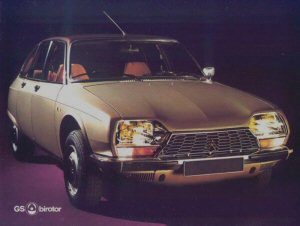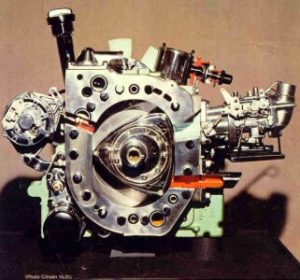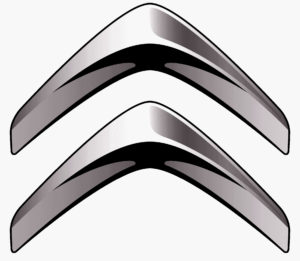With three major new models being released in such a short period of time (the GS, the SM and the CX), Citroën were betting the house on their success.
While all three were superb cars, none were particularly economical – especially the GS. At the same time, Citroën were investing heavily in the Wankel rotary engine, and had very publicly tested the concept in the hydraulically suspended Ami M35 coupe, before releasing the GS Birotor. A tri-rotor engine was in development to replace the old DS motor the CX had been launched with – then the oil crisis hit, bringing the company to the very brink of bankruptcy again…
Rotary History: The Citroën Connection
 Most Rotary History readers know that Mazda and Wankel pioneer NSU actually produced and sold Wankel-engined cars. But few know that a third Western manufacturer did too: Citroën S.A. of France. In 1967 it set up Comotor S.A. in Luxembourg as a joint venture with NSU to produce vehicle engines. Citroën’s cars would use Comotor’s engines.
Most Rotary History readers know that Mazda and Wankel pioneer NSU actually produced and sold Wankel-engined cars. But few know that a third Western manufacturer did too: Citroën S.A. of France. In 1967 it set up Comotor S.A. in Luxembourg as a joint venture with NSU to produce vehicle engines. Citroën’s cars would use Comotor’s engines.
In 1970 Citroën’s first Wankel car appeared: the single-rotor M35, a small 2-door based on the existing Ami-8. The four-speed, front-drive M35 was sold only in France to high-mileage drivers for the equivalent of $2,740 as an experiment. Out of 500 planned, 260 were actually built (one source says 350, but most agree on the lower number), but those cars accumulated 18.5 million miles (30 million km). The rotor radius (-prime) x eccentricity x width (R’ x e x B) were 102.0 x 14.0 x 67.0 mm, giving a displacement of 498 cc (30.3 ci). The engine put out 55 hp at 5500 rpm and 51 lb-ft of torque at 2745 rpm and had a 7500 rpm redline. In tests by Jan Norbye for his book The Wankel Engine, the 1,793-lb (813 kg) M35 took 18.0 seconds to get from 0 to 60 mph and had a top speed of 90 mph. These figures seem slow but were good for European cars of that size at that time.

Next was the GS Birotor, a rather larger front-drive 4-door car already in production as the GS with an air-cooled piston engine. This car, announced in 1973, had a water-cooled 2-rotor engine with the same basic dimensions as the M35’s, producing 107 hp at 6500 rpm and 103 lb-ft at 3000 rpm. With a standard semi-automatic transmission like the comparable NSU Ro80 with its closely related engine, the Birotor could reach 109 mph (175 kph), quite good for the time. As production was about to begin, though, the first oil crunch hit – just as word about the Wankel’s poor mileage and NSU’s rotary durability problems was spreading. Only 874 Birotors were built before production ended in early 1975 (the regular GS, later updated to become the GSA, remained available well into the ’80s) and very few survive. Citroën crushed the unsold cars and those it was able to buy back.
The Comotor engines were based on the trouble-prone NSU designs, but the firm had made many changes to improve durability and economy. The GS Birotor would probably have proven more reliable than the Ro80. This isn’t idle speculation: the only survivor with right-hand drive, now in Australia, was supposedly used as a daily driver for over 20 years but is only on its second engine. Citroën was renowned for its engineering and might have restored the Wankel’s reputation in Europe. But it had been losing money for years and was already pulling out of the US market by 1974. The rotary fiasco didn’t help. Peugeot, known to be anti-Wankel, took over the firm that year and still has control. There were to be no more rotary Citroëns, but Comotor struggled on until 1980.

Ironically, a Comotor engine very much like the version in the Birotor was offered in one other vehicle – the Van Veen OCR 1000 motorcycle sold in small numbers in the late ’70s. This heavy bike – over 700 lb (320 kg) – could hit 125 mph (200 kph) in just 16 seconds and reached 135 mph (215 kph) in tests. The OCR 1000 cost over $15,000 by late 1978, about the time production ended after some 30 units were built. Such a machine is a fitting end to the Citroën/Comotor saga.
POSTSCRIPT: Of course, neither the regular GS/GSA or the GS Birotor were ever sold in the US, and no examples of the GS Birotor are known to exist in the US. The Birotor drivetrain was completely different from that of the normal GS, not least because the rotary was water-cooled. In addition, interiors were rather different in the Birotor, and aside from the ‘Birotor’ logos, the exterior had subtly flared fenders. If you thought about buying a normal GS and converting it, forget it. Citroën crushed the cars in part to avoid having to carry spares, though a quarter century later this issue is moot.
Citroën Car Club notes: As well as the M35 and Birotor, there were rumours of a triple rotor version of the CX. The Oil Crisis and resulting death of the Wankel as a viable mass-production engine hit before the CX could be launched. However, it has to be borne in mind that the GS Birotor is more akin to a CX than a GS under the skin.


